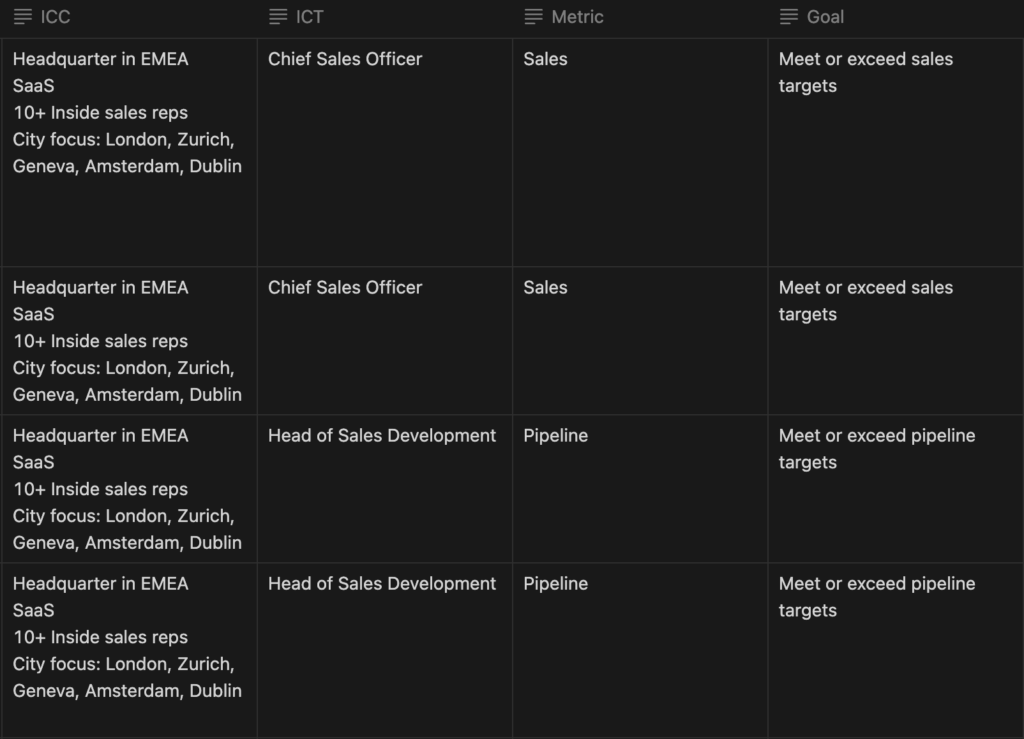In today’s issue, I’ll share the exact process I follow to find prospects’ problems. If you can replicate these steps, you’ll be able to catch the attention of your prospects, because you’ll show them you understand what problems they are trying to solve, in details.
Understanding prospects’ problems is a big mindset shift for many salespeople because they are trained to sell a product, and pitch features and benefits, instead of trying to put themselves in the shoes of their customers.
That’s what I’m going to show you, step-by-step:
Every prospect you are trying to reach has one or more metrics they are evaluated on. A VP of Sales will be evaluated on revenues, a CFO on bottom-line, a CPO on shipping speed and so on. Your prospects get promoted or fired based on their performance against these metrics.
Your goal when finding prospects’ problems is to get a clear understanding of these metrics, and the goals associated with these metrics.
Here are a few places where you can get an idea of these metrics and goals:
When you have an idea of the metrics your prospects are evaluated on, your next step is to understand their goals. You can ask yourself the following questions:
Below are some examples for different types of prospects:

When you have a clear metric and goal, you need to find out the initiatives related to these goals. Ask yourself the following questions:
Again, look for any information that can help you understand these initiatives in podcasts, webinars, 10-K reports, and so on.
Here’s an example of what an initiative could look like:

Now that you know more about their initiatives, you can start listing problems they would typically face when pursuing these initiatives.
Ask yourself the following questions:
Here’s an example of problems related to initiatives:

Finally, list the exact symptoms of these problems, so you can highlight them in your prospecting messages.
Problems are often not enough to get a reply. They tend to be vague and full of jargon. For example, “Not having an upsell playbook” is a problem a lot of my prospects have.
Symptoms of this problem are:
I like to compare this with a doctor consultation. When you say “I have a cold”, you’re mentioning a sickness (a problem), but when your doctor asks you about your symptoms, you’ll say you:
Think about what is more vivid in your mind? Problems or symptoms? It’s the same with prospects.
Here’s an example of typical symptoms:

And these are the 4 steps you can follow if you want to find your prospects’ problems.
Hope this helps.
Cheers,
Thibaut
P.S. This is a small preview of my flagship course, The Prospecting Engine. 14 chapters and 114 lessons of instructional video that will teach you how to start conversations, book meetings, and generate a healthy pipeline in 2024 and beyond. (even if you’re just getting started).
P.S. When you’re ready, here are 3 ways I can help you:
→ (NEW) Enroll in The Prospecting Engine
→ (NEW) Need to train your team or invite me as a speaker? Book a call here
Get my free, 4 min weekly newsletter. Used by 5.400+ salespeople to book more meetings and work when, where, and how they want.
Get my free, 4 min weekly newsletter. Used by 5.400+ salespeople to book more meetings and work when, where, and how they want.
I will never spam you, or sell your info.
Get each episode in your mailbox when they release. Grab special discounts and offers.